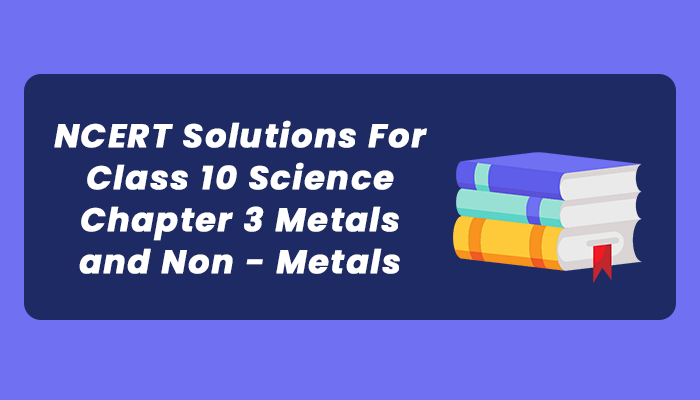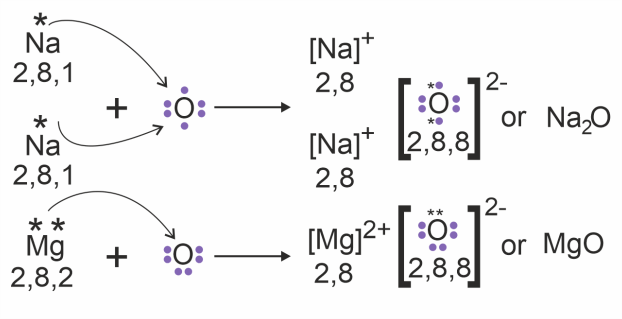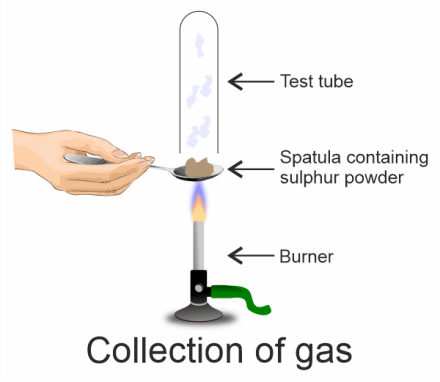NCERT Solutions Class 10 Science Chapter 3 Metals and Non-Metals
NCERT Class 10 Science Chapter 3 Metals and Non-Metals Solution: This NCERT solution for class 10 has been designed with proper research and explanation. Candidates who are looking for the NCERT Science solution of chapter 3 can refer to the solutions given below. Each solution has been explained with a proper explanation as far as applicable. Here students can find the solution to all the questions in the NCERT book. Whether the question is from inside the book or activity or exercise question, every solution has been provided below. Students can score good marks in exams and it can even help them to solve their homework so that they can save extra time for self-study. Chapter 3 NCERT Solutions Class 10 Science Inside Chapter QuestionsPage Number: 40Question 1: Give an example of a metal which:
Answer: i.) Mercury is a metal which remains liquid at room temperature. Mercury is liquid at room temperature because mercury is very bad at sharing electrons with its neighbouring atom. ii.) Sodium is metal which can be easily cut with a knife. It is an alkali metal. iii.) Silver is the best conductor of heat because its free electrons move very easily as compared to other metals. iv.) Lead is a poor conductor of electricity because it lacks free electrons which are responsible for any kind of conduction. Question 2: Explain the meanings of malleable and ductile. Answer: Malleable: Malleable is a characteristic of metals which means that metals can be beaten into sheets if they are hammered. Gold, Silver, Platinum, and Copper are a few examples of metals which can be beaten into sheets i.e. they show a malleable property. Ductile: Ductile is also one kind of property that a metal posses. Ductile means that metals can be stretched into wires. A lot of metals show ductility properties and here are a few of them, copper, nickel, gold, etc. Chapter 3 NCERT Solutions Class 10 Science inside Chapter QuestionsPage Number: 46Question 1: Why sodium is kept immersed in kerosene oil? Answer: Sodium is a highly reactive metal and reacts with oxygen and moisture very vigourously. It is also not stored in water because even water has oxygen and sodium being highly reactive will also react with water. This may cause an accidental fire. So to avoid accidents sodium is kept immersed in kerosene. Sodium is stored in kerosene because sodium has a higher density compared to kerosene as a reason it does not react with it. Question 2: Write equations for the reactions of:
Answer: i.) Reaction of iron with steam looks like the following chemical equation: 3Fe + 4H2O → Fe3O4 + 4H2 When iron reacts with steam it forms either Iron (II) or Iron (III) oxide and hydrogen gas. ii.) Reaction of calcium and potassium in the water looks like the following chemical equation: When Calcium reacts with water it forms calcium hydroxide and hydrogen gas. Ca + 2H2O → Ca(OH)2 + H2 When Potassium reacts with water it forms potassium hydroxide and hydrogen gas. 2K + 2H2O → 2KOH + H2 + Heat Question 3: Samples of four metals A, B, C and D were taken and added to the following solution one by one. The results obtained have been tabulated as follows:
Use the Table above to answer the following questions about metals A, B, C and D.
Answer: i.) In the above table iron is the most reactive element. So from the table, we can see that only B shows a displacement reaction with Iron (II) Sulphate. We know that in a displacement reaction a more reactive metal displaces a less reactive metal. Since B has displaced iron from Iron (II) Sulphate therefore we can conclude that B is most reactive than other metals in the given table. ii.) B, as concluded above, will displace iron from Iron (II) Sulphate, therefore, we can say that B will also displace copper from Copper (II) Sulphate Solution because copper is less reactive than iron so it will be less reactive than B also. So B on reaction with Copper (II) Sulphate will show a displacement reaction where the blue colour of the Copper (II) Sulphate Solution will fade away and a deposit will be formed on metal B which will be red-brown in colour. iii.) We have concluded above that B is most reactive because it displaces iron from Iron (II) Sulphate. After iron, the most reactive element is copper so A displaces the Copper (II) Sulphate solution. C displaces silver nitrate whereas metal D does not show any reaction at all so it becomes the least reactive. Therefore if we arrange A, B, C, and D, in order of decreasing reactivity then it will be: B > A > c > D. Question 4: Which gas is produced when dilute hydrochloric acid is added to a reactive metal? Write the chemical reaction when iron reacts with dilute H2SO4. Answer: When dilute Hydrochloric acid is added to a reactive metal, the reaction produces hydrogen gas. The equation for the chemical reaction between iron and dilute H2SO4 is given below. Fe (s) + H2SO4 (aq) → FeSO4 (aq) + H2 (g) Question 5: What would you observe when zinc is added to a solution of iron (II) sulphate? Write the chemical reaction that takes place. Answer: Iron is less reactive than zinc so it is obvious that there will be a displacement reaction between iron and zinc where iron will get displaced from its salt solution of Iron (II) Sulphate. Also, the Iron (II) sulphate is greenish in colour which will fade away during the reaction because of the formation of zinc sulphate and since iron is getting displaced it will get deposited on zinc. The equation for the chemical reaction between iron (II) sulphate and zinc is given below: FeSO4 + Zn → ZnSO4 + Fe Chapter 3 NCERT Solutions Class 10 Science inside Chapter QuestionsPage Number: 49Question 1: i.) Write the electron dot structures for sodium, oxygen and magnesium. ii.) Show the formation of Na2O and MgO by the transfer of electrons. iii.) What are ions present in these compounds? Answer: i.) Electron dot structure for sodium, oxygen and magnesium is given below. 
ii.) Formation of Na2O and MgO by the transfer of electrons takes place in the following way. 
iii.) The ions present in the compounds are: Na2O contains, Na+ and O2- ions. MgO contains, Mg2+ and O2- ions. Question 2: Why do ionic compounds have high melting points? Answer: Each ionic compound is made up of positive ions called cations and negative ions called anions. Since the ions are opposite in charge therefore they strongly attract each other which creates a very strong force of attraction and to break this force a lot of heat energy is required. So, to melt the ionic compound more heat is required. And, because of this strong force of attraction between the charged ions, compounds have high melting points. Chapter 3 NCERT Solutions Class 10 Science inside Chapter QuestionsPage Number: 53Question 1: Define the following terms:
Answer: i.) Minerals: These are the natural chemical materials or substances found in the earth's crust. ii.) Ore: These are the combinations of minerals and impurities from which metals can be extracted easily. Basically, metals found on earth that carry lots of impurities are called ores. iii.) Gangue: The impurities present in an ore are called gangue. These impurities can be anything and some of its examples are mica, earth particles, limestone, sand, rocky materials, etc. Question 2: Name two metals which are found in nature in the free state. Answer: Gold is one of the metals which is found in a pure state in nature and the other one is platinum. Question 3: What chemical process is used for obtaining a metal from its oxide? Answer: The process used for extraction of metal from its oxide is reduction. A few examples of this process are given below. i.) When zinc oxide is heated with carbon then metallic zinc is obtained. ZnO (s) + C (s) → Zn (s) + CO (g) Apart from carbon, there are lots of other highly reactive metals used in reduction as reducing agents. Some of their examples are aluminium, calcium, sodium, etc. Basically, a highly reactive metal displaces a low reactive metal from its oxides. Class 10 Metals and Non-Metals SolutionsPage Number: 55Question 1 Metallic oxides of zinc, magnesium and copper were heated with the following metals:
In which cases will you find displacement reactions taking place? Answer: A more reactive metal can displace a less reactive metal from its oxide. But out of zinc, magnesium, and copper metals, magnesium is the most reactive, zinc is less reactive whereas copper is the least reactive metal.
Question 2: Which metals do not corrode easily? Answer: Gold and Platinum are the two metals which don't corrode easily Question 3: What are alloys? Answer: Alloys are homogeneous mixture which contains two or more metals, or metal and non-metal. Example - Copper and tin form an alloy called bronze. Class 10 Science Chapter 3 Metals and Non-Metals Exercise SolutionsQuestion 1: Which of the following pairs will give displacement reactions?
Answer: d.) AgNO3 solution and copper metal will give a displacement reaction because copper is a more reactive element than silver, so displaces silver from the silver nitrate solution. Also, in the metal reactivity series copper comes before gold. Question 2: Which of the following methods is suitable for preventing an iron frying pan from rusting?
Answer: c.) Applying a coating of zinc is suitable for preventing an iron frying pan from rusting because zinc is cheap and it also forms a thin layer which protects iron from reacting with oxygen. Question 3: An element reacts with oxygen to give a compound with a high melting point. This compound is also soluble in water. The element is likely to be
Answer: a.) Calcium. When calcium reacts with oxygen it gives calcium oxide. Ca (s) + O2 (g) -> CaO (s) The calcium oxide formed is an ionic compound with a strong ionic force of attraction between calcium ion Ca+2 and oxide ion O-2. The ions have a strong electrostatic force between them because of which calcium oxide has a high melting point. Calcium Oxide is also soluble in water and forms calcium hydroxide as shown below CaO (aq) + H2O (l) -> Ca (OH)2 (aq) Question 4: Food cans are coated with tin and not with zinc because
Answer: d.) Zinc is more reactive than tin. Question 5: You are given a hammer, a battery, a bulb, wires and a switch.
Answer: a.) With a hammer, metals can be pounded into thin sheets without shattering. It is impossible to hammer non-metals into thin sheets. When pounded, non-metals shatter into fragments. Non-metals cannot be moulded, although metals can. By using a battery, bulb, wires, and switch when we connect metals into a circuit, current flows through the circuit and the bulb illuminates. The bulb completely fails to illuminate when non-metals (such as sulphur) are connected. Metals are effective electrical conductors. b.) Metals can be cast into sheets because of their malleability. As good electrical conductors, metals can be utilised for electrical wires. Question 6: What are amphoteric oxides? Give two examples of amphoteric oxides. OR Write chemical equations that show aluminium oxide reacts with acid as well as a base. Answer: Amphoteric metal oxides are those that exhibit both basic and acidic behaviour. In other terms, amphoteric oxides are metal oxides that react with both acids and bases to produce salt and water. Amphoteric materials include zinc oxide and aluminium oxide. Question 7: Name two metals which will displace hydrogen from dilute acids and two metals which will not. Answer: i.) In the activity series, metals above hydrogen like sodium and magnesium remove hydrogen from weak acids. ii.) In the activity series, metals below hydrogen like copper and silver do not displace hydrogen from diluted acids. Question 8: In the electrolytic refining of a metal M, what would you take as the anode, the cathode and the electrolyte? Answer: Cathode - Pure Metal Anode - Impure Metal Electrolyte - Metal Salt Solution Question 9: Pratyush took sulphur powder on a spatula and heated it. He collected the gas evolved by inverting a test tube over it, as shown in the figure. 
a.) What will be the action of gas on
b.) Write a balanced chemical equation for the reaction taking place. Answer: when sulphur is heated in air, it forms sulphur dioxide (SO2). i.) The sulphur dioxide is neutral gas, so it will have no action on the dry litmus paper. ii.) The gas will turn moist litmus paper red as when SO2 reacts with water, it forms sulphurous acid (H2SO3), as it is an acid, it will turn blue litmus red. Question 10: State two ways to prevent the rusting of iron. Answer: Painting and galvanising are two ways to stop iron from rusting. Question 11: What type of oxides are formed when non-metals combine with oxygen? Answer: Oxygen and non-metals react to form acidic or neutral oxides. Question 12: Give reasons:
Answer: a.) Malleability and ductility are the two important properties of these metals. So, platinum, gold and silver are used to make jewellery. Apart from it, these do not corrode easily. b.) Lithium, sodium, and potassium are all highly reactive metals that ignite when exposed to air. This is due to their strong reactivity and low ignition temperature. So, they are stored under oil. c.) On the surface of aluminium, an inert layer of aluminium oxide forms. This layer stops aluminium from reacting with other materials. Because of this, aluminium is utilised to create cooking equipment. d.) A metal oxide is simpler to convert into free metal. The carbonate and sulphide ores are first transformed to oxides in order to extract the metals since it is simpler to acquire metals from their oxides than from their carbonates or sulphides directly. Question 13: You must have seen tarnished copper vessels being cleaned with lemon or tamarind juice. Explain why these sour substances are effective in cleaning the vessels. Answer: Substances like lemon or tamarind juice contain acids. These acids dissolve up any kind of copper oxide which has been formed on the surface of the copper vessels and hence it is more effective in cleaning the vessels. Question 14: Differentiate between metal and non-metal on the basis of their chemical properties. Answer: The difference between metals and non-metals are:
Question 15: A man went door-to-door posing as a goldsmith. He promised to bring back the glitter of old and dull gold ornaments. An unsuspecting lady gave a set of gold bangles to him which he dipped in a particular solution. The bangles sparkled like new but their weight was reduced drastically. The lady was upset but after a futile argument, the man beat a hasty repeat. Can you play the detective to find out the nature of the solution he has used? Answer: The goldsmith played smart with the lady by dipping the bangles in aqua-regia. The aqua-regia mixture was used by the goldsmith to execute this fraud. This mixture comprises 1 part of concentrated nitric acid and 3 parts of concentrated hydrochloric acid by volume. When the gold bangles were dipped in this solution, the gold got dissolved in a large quantity as a result of which the weight of the bangles got reduced. The goldsmith can easily recover the dissolved gold from the aqua-regia solution by proper methods. Question 16: Give reasons why copper is used to make hot water tanks and not steel (an alloy of iron). Answer: i.) Between steel and copper, copper is a good conductor of heat. ii.) The steel corrodes easily compared to copper. iii.) There is no reaction of copper with water at any temperature on the other hand iron reacts with water on heating.
Next TopicClass 10 Science Chapter 4
|
 For Videos Join Our Youtube Channel: Join Now
For Videos Join Our Youtube Channel: Join Now
Feedback
- Send your Feedback to [email protected]
Help Others, Please Share









